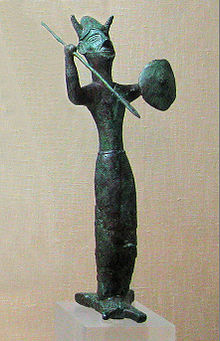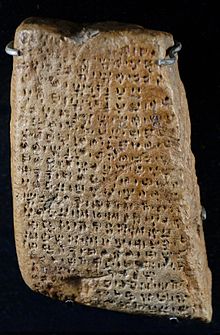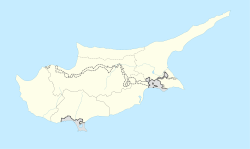Enkomi (archaeological site)
| Location | Island of Cyprus |
|---|---|
| Coordinates | 35°9′35″N 33°53′18″E / 35.15972°N 33.88833°E |
| Site notes | |
| Excavation dates | 1895–1898, 1930, 1934, 1958-1973 |
| Archaeologists | Alessandro Palma di Cesnola, A. S. Murray, Einar Gjerstad, Claude F. A. Schaeffer, Porphyrios Dikaios, Oliver Pelon |
| Public access | Yes |
Enkomi (also Mallia) is a 2nd millennium BC archaeological site on the eastern coast of Cyprus some distance from the village of Enkomi. The site appears to currently be under disputed governance. A number of Cypro-Minoan Script inscriptions were found there including the longest known clay tablet. It has been suggested that this city was the Alashiya of the Amarna Letters and in texts from several areas of the ancient Near East.[1] The site is known for the hundreds of rich tombs that have been excavated there and for exceptional metallurgic finds like the Ingot God and the Horned God.
History
[edit]
The chronology of Cyprus during the later half of the 2nd millennium BC is defined as follows:[2]
- Late Cypriot I LC I 1650–1550 BC
- Late Cypriot IIA LC IIA 1550–1450 BC
- Late Cypriot IIB LC IIB 1450–1300 BC
- Late Cypriot IIC LC IIC 1300–1200 BC
- Late Cypriot IIIA LC IIIA 1200–1100 BC
- Late Cypriot IIIB LC IIIB 1100–1050 BC
Enkomi was settled in the Middle Bronze Age, near an inlet from the sea (now silted up). From about the 16th century BC to the 12th, it was an important trading center for copper, which was smelted at the site, with strong cultural links to Ugarit on the facing coast of Syria.[3]
The complicated and badly disturbed stratigraphy of the site has four major phases, with many subdivisions:
- Level A, Middle Bronze, a poorly represented preliminary stratum on bedrock. Pottery and scarabs found there led the excavators to date the level to 1900 to 1700 BC. The site then had a period of abandonment leaving a sterile stratum in the archaeological record;[4][3]
- Level I A, and B, at the beginning of the Late Bronze Age. Dated by the excavators to have started slowly, c. 1550 BC, reached property by c. 1500 BC, and been destroyed by an earthquake c. 1400 BC. Corresponds to the Late Cypriote I and II;[4]
- Level II A, and B, with many subdivisions, covering the elaborate expansion of the 14th and 13th centuries and ending in a mass destruction about 1220;
- Level III A, B, and C, with Mycenaean settlers, with a destructive attack, possibly related to the Sea Peoples in IIIA, culturally continuous with IIIB, ending in a destruction about 1125, and IIIC, a final, Mycenaean phase with dwindling population.[5]
Archaeology
[edit]

Following more than a decade of widespread looting drawn by the high quality of the tomb gifts Alessandro Palma di Cesnola drew the attention of archaeologists to the site after very briefly digging there.[6] Most of the early excavations focused on the tomb area. The settlement remains were thought to be from the Byzantine period and a substantial portion were destroyed assuming they were unimportant. A. S. Murray worked there for the British Museum in 1895–1898. A total of 100 tombs were excavated. Under then current laws 2/3 of the finds went to the British Museum and the rest to the Cyprus Museum. Publishing of the excavation results was quite thin, covering mainly only high status items.[7] In 2003 the original excavation field notebook was published, detailing most of the individual tomb excavations.[8] Unsuccessful trial excavations, also in the tomb area, were conducted in 1913 by the Cyprus Museum and in 1927 by R. Gunnis though the latter did discover a hoard of bronzes.[9][10] In 1930 a Swedish Cyprus Expedition team led by Einar Gjerstad excavated for two months in the tomb area, uncovering 22 "productive" tombs. Human remains were found seated and supine with robes fastened by gold pins, with grave goods of gold, silver, faience, and ivory. Some had diadems on their foreheads decorated with geometric ornaments, floral motifs or figures, and gold tin over their mouths. Ceramic and bronze vessels contained food and drink offerings.[11][12][13] It has been suggested that one pottery shard was manufactured in Canaan, specifically in Ashdod but this is not certain.[14][15] As they assumed that burial and settlement areas were separated they used a pit digging technique that ended up destroying settlement remains:
"I made the worst kind of mistake a scholar can make: I was working on a pre-conceived idea. Since burial-grounds and settlements were topographically separated, as far as was known, during the whole Bronze Age in Cyprus, there was no reason to suppose that there were other habits in Enkomi"[10]

After Claude F. A. Schaeffer put in trial trenches in 1934 (putting in about 200 soundings and partially excavating one building he named the Maison des Bronzes, excavations were conducted between 1948 and 1973 by a joint expedition between Claude F. A. Schaeffer for the French Expedition and Porphyrios Dikaios on behalf of the Cyprus Department of Antiquities. Early work determined that the site had been protected by a Cyclopean wall constructed of stone othostat slabs up to 3.5 meters long.[16][17][18][19][20] The wall enclosed an area of about 2.5 hectares.[21] Cypriot excavations were conducted from 1848 until 1958 under Porphyrios Dikaios. French excavations, on behalf of the Centre national de la recherche scientifique, proceeded under Claude F. A. Schaeffer until 1970 at which point the expedition was led by Oliver Pelon. Excavation ended with the Turkish invasion of Cyprus and the status of excavated objects in Mission storage are currently unknown.[22][23][10]

An extensive metallurgy industry was found at Enkomi.[24] Numerous production facilities, raw materials, and finished products were excavated, including three copper oxhide ingots (one at the Cyprus Museum and one at Harvey Mudd College). The most notable finished good finds were the "Ingot God", a statue wearing a horned conical hat and greaves, armed with shield and spear, and standing on a miniature hide-shaped ingot, and "Horned God".[25][26][27]
The Horned God, measuring 0.55 meters in height, was found in a pit dug in the third phase of a very large tripartite ashlar building, built in the Late Cypriot III period (early 12th century BC) over earlier structures destroyed by an earthquake, also the dating of the statue. Large numbers of oxen skulls, stag antlers, animal bones, and miniature horns of gold sheet and other gold ornaments were found in the area in which the statue had originally stood, suggesting ritual activity. This level was also destroyed.[28][29]
A decorated metal cup, the "Enkomi Cup" has been controversially claimed to use niello decoration, which would make it one of the earliest uses of this technique. However, controversy has continued since the 1960s as to whether the material used actually is niello.[30][31]
There are thought to have been around 2000 tombs at the site. Most of the archaeological work at Enkomi has been on the intra-settlement tombs. The 1896 British team excavated about 100 tombs, mostly already looted. The Swedish work in 1930 excavated 28 tombs. In the most recent excavations, the French team dug 37 tombs and the Cypriot team excavated 30.[32] Of the excavated tombs, most were chamber tombs. One was a tholos tomb (Tomb 71) and four were built tombs (Tombs 1, 11, 12 and 66).[33]
Cypro-Minoan Script finds
[edit]
In 1967 a small terracotta cylinder (#097 ENKO Arou 001) was found at Enkomi. It is dated to the Late Cypriot IIA–B period (fourteenth century BC) and is inscribed in the Cypro-Minoan 1 (CM1) variant, sometimes called Linear C. The text is the longest CM1 text found outside Syria. The cylinder holds 27 lines lines of text with 217 signs in total. The Cypro-Minoan Script is yet untranslated nor is the underlying language known with certainty.[34]

Four Cypro-Minoan Script tablets have also been found, three in the Cyprus Museum in Nicosia and the last in the Louvre Museum.[35] One tablet (#1885) was found in the north area of the site in "room 103 of the Late Cypriote I building called the Fortress", with only the top portion remaining. It is written in the Cypro-Minoan variant and dates to LC IB (1525–1425 BC) and contains 23 total signs, 21 on the obverse and 2 on the edge.[36] Two other tables were found in a Late Cypriote III context, one (#1193 in two fragments) dated to LC IIIB (12th century BC) in the north area and one (#1687) dated to LC IIIA (late 13th-early 12th century BC) in the central area.[37] One, AM 2336, is of unknown context.[1][38]
Short Cypro-Minoan inscriptions were found on three terracotta vessel. fragments. The first (Inv. 1904, PI. VI a) has four signs and part of a fifth and is dated to Mycenaean III C:lb (c. 1200 BC). The second (Inv. 4025, PI. VI b) contains six signs in two lines and is also dated to Mycenaean III C:lb (c. 1200 BC). The third (Inv 1848/12 PI. Vic) contains a single character incised after baking and its dating is unclear.[39] Another example, found in a looted tomb during the 1913 trial excavation has 7 signs and also is uncertain date.[40] A single clay ball (AS 2226), held in the Louvre Museum, bears two signs.[41]
See also
[edit]References
[edit]- ^ a b Goren, Yuval, et al., "The Location of Alashiya: New Evidence from Petrographic Investigation of Alashiyan Tablets from El-Amarna and Ugarit", American Journal of Archaeology, Vol. 107, no. 2, pp. 233–55, 2003
- ^ Crawford, Katherine A., and Marc-Antoine Vella, "Cyprus Dataset: Settlements from 11000 BCE to 1878 CE", Journal of Open Archaeology Data 10.7, pp. 1-6, 2022
- ^ a b Crewe, Lindy, "The Foundation of Enkomi: A New Analysis of the Stratigraphic Sequence and Regional Ceramic Connections", Vol. 37, Verlag der Österreichischen Akademie der Wissenschaften, 2007
- ^ a b Schaeffer, C. F. A., "Enkomi", American Journal of Archaeology, Vol. 52, no. 1, pp. 165–77, 1948
- ^ Mountjoy, P. A., "The end of the Bronze Age at Enkomi, Cyprus: the problem of Level III B1", Annual of the British School at Athens 100, pp. 125-214, 2005
- ^ Munro, J. A. R., and H. A. Tubbs, "Excavations in Cyprus 1890", Journal of Hellenic Studies XIL, pp. 59-198, 1891
- ^ Murray, A. S., A. H. Smith and Η. B. Walters, "Excavations in Cyprus", Trustees of the British Museum, London, 1900
- ^ [1]Tatton-Brown, V., "Enkomi: the notebook in the British Museum", Cahierdu Centre d'Etudes Chypriotes 33, pp. 9-65, 2003
- ^ Myres, J.L., "Excavations in Cyprus, 1913", Annual of the British School at Athens 41, pp. 53–104, 1940–45
- ^ a b c [2]Crewe, Lindy, "From lithograph to web: the British museum's 1986 Enkomi excavations", Κυπριακή Αρχαιολογία Τόμος V (Archaeologia Cypria, Vol. V), pp. 57-70, 2007
- ^ [3]Gjerstad, E., J. Lindros, E. Sjoqvist and A. Westholm, "The Swedish Cyprus expedition: finds and results of the excavation in Cyprus 1927-1931. Vol. 1 (Text)", Stockholm: Victor Pettersons bokindustriaktiebolag, 1934
- ^ [4]Gjerstad, E., J. Lindros, E. Sjoqvist and A. Westholm, "The Swedish Cyprus expedition: finds and results of the excavation in Cyprus 1927-1931. Vol. 2 (Text)", Stockholm: Victor Pettersons bokindustriaktiebolag, 1935
- ^ [5]Gjerstad, E., J. Lindros, E. Sjoqvist and A. Westholm, "The Swedish Cyprus expedition: finds and results of the excavation in Cyprus 1927-1931. Vol. 3 (Text)", Stockholm: Victor Pettersons bokindustriaktiebolag, 1937
- ^ Gunneweg, Jan, et al., "A Canaanite Jar from Enkomi", Israel Exploration Journal, Vol. 37, nos. 2/3, pp. 168–72, 1987
- ^ Mazar, Amihai., "A Note on Canaanite Jars from Enkomi", Israel Exploration Journal, Vol. 38, no. 4, pp. 224–26, 1988
- ^ Schaeffer, C. F. A., "Missions en Chypre. 1932-1935", Academie des Inscriptions et Belles Lettres, Foundation Marius Fontane, Voyages Archeologiques, Paris, 1936
- ^ Dikaios, P., "Enkomi. Excavations 1948-1958. Vols. I-IIIB.", Verlag Philipp von Zabern, Mainz am Rhein, 1969-71
- ^ Schaeffer, C. F. A., "Enkomi-Alasia. Nouvelles Missions en Chypre 1946-1950", Paris, 1952
- ^ Schaeffer, C. F. A., et al., "Fouilles d’Enkomi-Alasia Dans l’île de Chypre, Campagne de 1967. Rapport Préliminaire", Syria, Vol. 45, nos. 3/4, pp. 263–74, 1968
- ^ Schaeffer, C. F. A., (ed.), "Alasia I, Mission archeologique d'Alasia IV", Paris, 1971
- ^ van Wijngaarden, Gert Jan, "Enkomi-Ayios Iakovos", Use and Appreciation of Mycenaean Pottery in the Levant, Cyprus and Italy: (Ca. 1600-1200 BC), Amsterdam University Press, pp. 129–60, 2002
- ^ Pelon, Olivier, et al., "Rapport Sommaire Sur La XXIe Campagne de Fouilles a Enkomi-Alasia (Chypre), Mars-Avril 1971", Syria, Vol. 48, nos. 3/4, pp. 323–35, 1971
- ^ Pelon, Ο., E. and J. Lagarce, "La XXIIIe campagne de fouilles a Enkomi-Alasia (Chypre). Rapport preliminaire", Syria L, pp. 101-114, 1973
- ^ Courtois, J.-C., "L´activité métallurgique et les bronzes d´Enkomi au Bronze Recent (1650–1100 avant J.C)", in J.D. Muhly, R. Maddin & V. Karageorghis (eds), Early Metallurgy in Cyprus 4000–500 BC, Nicosia, pp. 155–174, 1982
- ^ Kassianidou, Vasiliki, "Metallurgy and metalwork in Enkomi–Revisiting Porphyrios Dikaios’ excavations", Ancient Cyprus today: museum collections and new research. SIMA 184, pp. 79-90, 2016
- ^ Kassianidou, V., "Metallurgy and metalwork in Enkomi: the early phases", in V. Kassianidou & G. Papasavvas (eds), Eastern Mediterranean Metallurgy and Metalwork in the Second Millennium BC, Oxford, pp. 94–106, 2012
- ^ Papasavvas, George, "A Change in Attitude: X-Ray Images of the Ingot God from Enkomi", “And in Length of Days Understanding”(Job 12: 12) Essays on Archaeology in the Eastern Mediterranean and Beyond in Honor of Thomas E. Levy, Cham: Springer International Publishing, pp. 1355-1390, 2023
- ^ Dikaios, Porphyrios, "The bronze statue of a horned god from Enkomi", Heft 1/1962, Archäologischer Anzeiger, Berlin, Boston: De Gruyter, pp. 1-40, 1962
- ^ Papasavvas, George, "Feasting, deposition and abandonment in the sanctuary of the Horned God at Enkomi", Structure, Measurement and Meaning. Studies on Prehistoric Cyprus in Honour of David Frankel. Edited by Jennifer M. Webb. Studies in Mediterranean Archaeology 143, pp. 245-60, 2014
- ^ Giumlia-Mair A, "The Enkomi cup: niello versus kuwano", in V Kassianidou and G Papasavvas (eds), Eastern Mediterranean metallurgy and metalwork in the second millennium BC. A conference in honour of James D. Muhly, Nicosia, 10th‒11th October 2009 (Oxford), pp. 107–116, 2012
- ^ [6]Wanhill, Russell, and Alessandra Giumlia-Mair, "The Enkomi Cup: macrophotographic damage assessment", Historical Metallurgy 54.1, pp. 1-8, 2023
- ^ [7]Graziadio, Giampaolo, and Elisabetta Pezzi, "The Late Bronze Age tombs at Enkomi: shaping a methodology for analysing funerary furniture", Researches in Cypriote History and Archaeology. Proceedings of the Meeting Held in Florence, April 29-30th 2009, pp. 19-32, 2010 ISBN 978-88-6453-134-2
- ^ Crewe, Lindy, "Feasting with the dead? Tomb 66 at Enkomi", Ancient Cyprus in the British Museum: Essays in Honour of Veronica Tatton-Brown 180, 27-48, 2009
- ^ Janko, Richard, "Eteocypriot in the Bronze Age? The Cypro- Minoan cylinder from Enkomi as an accounting document", Kadmos, vol. 59, no. 1-2, pp. 43-61, 2020
- ^ Ferrara, S., "Cypro-Minoan Inscriptions Vol. 1. Analysis", Oxford, 2012
- ^ Duhoux, Yves., "The Cypro-Minoan Tablet No. 1885 (Enkomi): An Analysis", Kadmos, Vol. 48, nos. 1-2, pp. 5-38, 2010
- ^ Porphyrios Dikaios, "The Context of the Enkomi Tablets", Kadmos, Vol. 2, no. 1, pp. 39-52, 1963
- ^ Ephron, Henry D., "The Jēsŏn Tablet of Enkomi", Harvard Studies in Classical Philology, pp. 39-107, 1961
- ^ Dlkaios, Porphyrios, "More Cypro-Minoan Inscriptions from Enkomi", Europa: Studien zur Geschichte und Epigraphik der frühen Aegaeis. Festschrift für Ernst Grumach, edited by William C. Brice, Berlin, Boston: De Gruyter, pp. 80-87, 1967
- ^ John L. Myres., "A Cypro-Mycenaean Inscription from Enkomi, Near Salamis in Cyprus", Man, Vol. 34, pp. 24–24, 1934
- ^ Axel W. Persson, "Some Inscribed Terracotta Balls from Enkomi", Danielsson Octogenario Dicatae, Upsalla, pp. 269–273, 1932
Further reading
[edit]- Antoniadou, Sophia, "The Impact of Trade on Late Cypriot Society: A Contextual Study of Imports from Enkomi", Archaeological Perspectives on the Transmission and Transformation of Culture in the Eastern Mediterranean, edited by Joanne Clarke, Council for British Research in the Levant (CBRL), pp. 66–78, 2005
- Courtois, J-C., "Alasia II. Les Tombes D'Enkomi le Mobilier Funeraire", Paris, 1981
- Courtois, J-C., "Alasia III. Les objets des niveaux stratifies d'Enkomi (Fouilles C.F.-A. Schaeffer 1947-1970)", Mission Archeologique dAlasia VI, Editions Recherche sur les civilisations, Memoire No. 33, Paris, 1984
- Courtois, J.-C, J. Lagarce and E. Lagarce, "Enkomi et le Bronze Recent ά Chypre", Leventis Foundation, Nicosia, 1986
- Crewe, L., "Early Enkomi. Regionalism, Trade and Society at the Beginning of the Late Bronze Age on Cyprus", (British Archaeological Reports International Series 1706), Oxford, 2007
- Ioannides, Demetrios, Vasiliki Kassianidou, and George Papasavvas, "A new approach to an old material: an examination of the metallurgical ceramic assemblage of Enkomi, Cyprus, with the use of handheld portable X-ray fluorescence spectrometry", Archaeological and Anthropological Sciences 13, pp. 1-17, 2021
- Krzyszkowska, Olga H., "The Enkomi Warrior Head Reconsidered", The Annual of the British School at Athens, Vol. 86, pp. 107–20, 1991
- Lagarce, Elisabeth, and Jacques Lagarce, "A Propos Du Masque A. 71. 1 d’Enkomi", Syria, Vol. 50, nos. 3/4, pp. 349–54, 1973
- Masson, Emilia, "Présence Éventuelle de La Langue Hourrite Sur Les Tablettes Chypro-Minoennes D’Enkomi", Journal of the Royal Asiatic Society of Great Britain and Ireland, no. 2, pp. 159–63, 1975
- Matthäus, Hartmut, "Kypro-minoische Schriftmarken aus Enkomi", Kadmos, Vol. 22, no. 2, pp. 137-150, 1983
- Peltenburg, E. J. (1999). "From isolation to state formation in Cyprus: ca. 3500–1500 BC". In Karageorghis, Vassos; Michalides D. (eds.). The development of the Cypriot economy from the prehistoric period to the present day. Nikosia. pp. 17–43.
{{cite book}}: CS1 maint: location missing publisher (link) - Schaeffer, Claude F. A. (1949). Nouvelles découvertes à Enkomi (Chypre). Paris: Académie des Inscriptions et Belles Lettres.
- [8]Tatton-Brown, Veronica, "Sculpture and Terracottas from Enkomi in the British Museum", Cahiers du Centre d’Études Chypriotes 30.1, pp. 17-25, 2000

